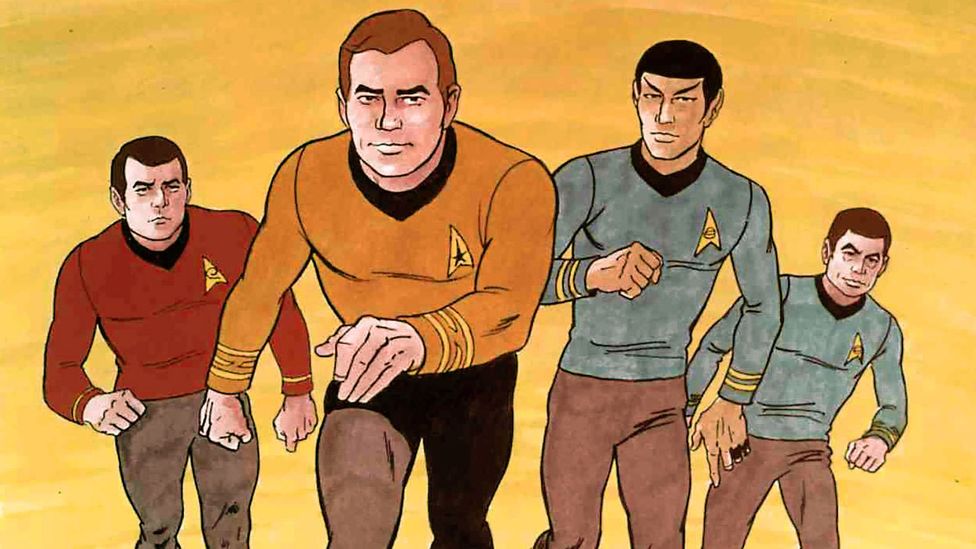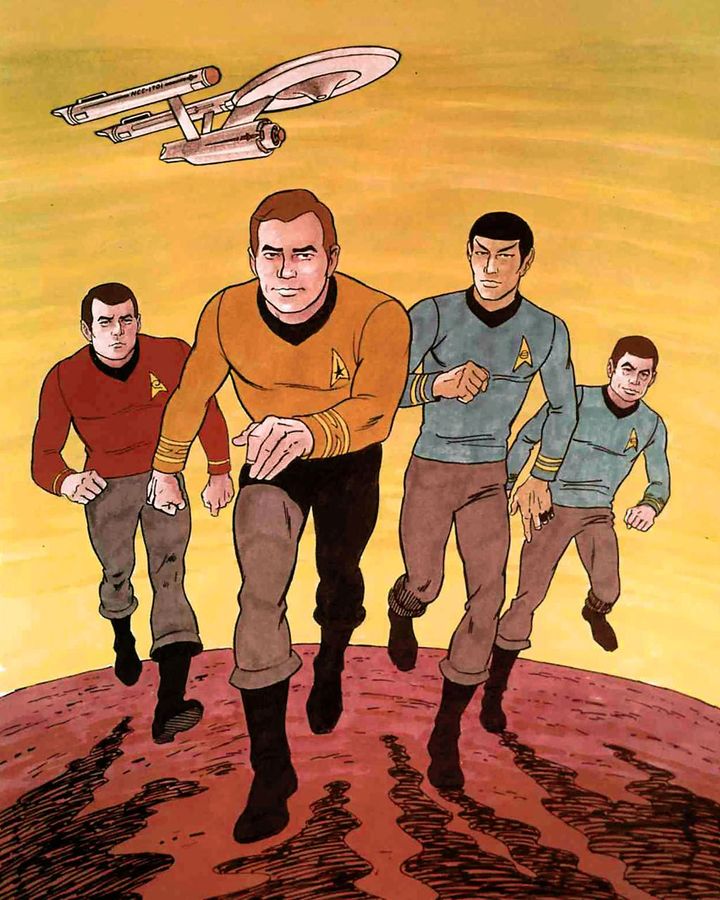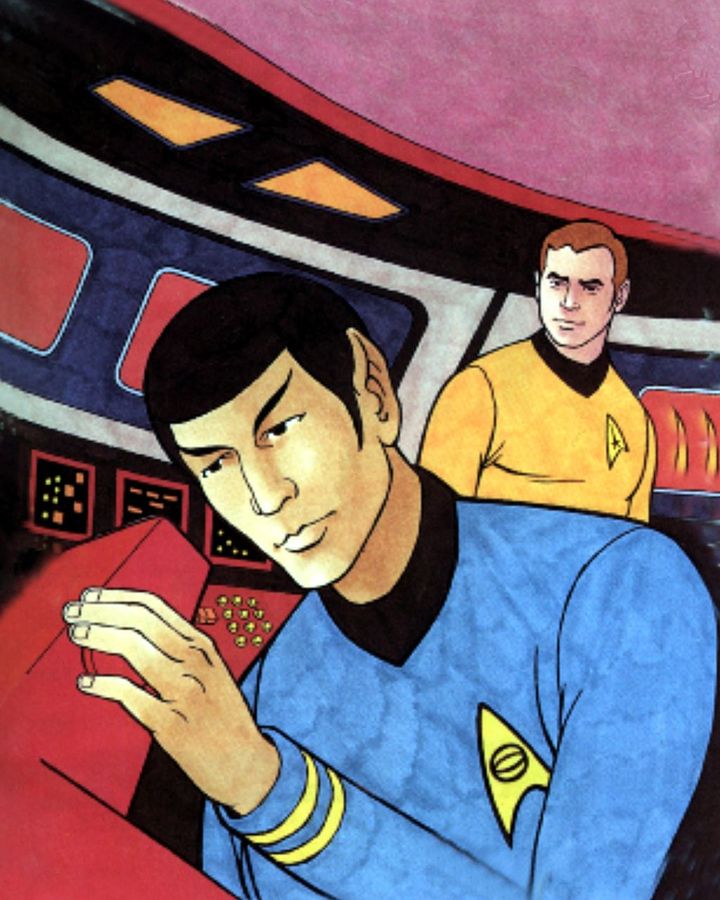
Star Trek: The Animated Series defined an in-between era for the franchise, much like what we’re facing now, writes Swapna Krishna. And whether or not it’s deemed to be part of the Star Trek “canon”, it shares the show’s vision for a utopian future where humans coexist peacefully with aliens.
O
On a remote planet, the Guardian of Forever sits, a passageway through time to other realities, locations, dimensions. All of a sudden, Captain Kirk comes through the portal, with Spock close behind him, fresh from an adventure observing the beginnings of the Orion civilisation. There’s just one problem: Dr Bones McCoy has no idea who Spock is – and neither does anyone else on the starship USS Enterprise.
This scene, from an episode called Yesteryear, doesn’t feature in any of the five core Star Trek series. The Original Series, The Next Generation, Deep Space Nine, Voyager, and Enterprise are modern classics that contain unending nostalgia for fans, but there’s another early Star Trek show that many people overlook – Star Trek: The Animated Series. It ran for just 20 episodes. Its status, and specifically whether it’s considered part of the “canon”, is uncertain. But it has an important legacy, bringing animation in as a key part of the franchise as well as keeping Star Trek in people’s minds during an in-between era, much like the one we’re entering now.
More like this:
– The most remarkable Star Trek episode ever made
– Star Trek and the kiss that changed TV
– What our science fiction says about us
When The Original Series was cancelled in 1969, it could have been the end of the road for Star Trek. But Gene Roddenberry, the franchise’s creator, wasn’t finished with his vision for a peaceful, diverse sci-fi future. While The Original Series had struggled in the ratings during its initial run, the show thrived in syndication, and created the phenomenon of fan conventions (think Comic-con in the present day). Because of this, studios were interested in more Star Trek, but there was a problem: the sets had been scrapped, the costumes were gone, and it would have been cost-prohibitive to rebuild everything from scratch.

Scotty, Kirk, Spock, McCoy and the Enterprise in The Animated Series (Credit: Alamy)
NBC settled on a different approach: an animated series. According to The Fifty-Year Mission by Mark Altman and Edward Gross (an oral history of Star Trek), Roddenberry wasn’t overly interested in an animated show in and of itself. However, he was willing to go along with it because he saw it as a stepping stone to another live-action show or a feature film. An animated show would energise fans, he thought, so he agreed on the condition that he would have full creative control of The Animated Series. After a fight, the network gave in. The full, regular cast returned, with the exception of Walter Koenig’s Pavel Chekov, who was cut for budget reasons.
The Animated Series was largely forgotten by all but the most ardent Trek fans, sandwiched between the iconic original series and The Next Generation, which premiered in 1987
Star Trek: The Animated Series premiered 50 years ago, in September of 1973 during Saturday morning cartoons, but the show wasn’t written for children. Instead, it was very much conceived of as a continuation of The Original Series. Some of the episodes were direct sequels, such as More Tribbles, More Trouble, which is a continuation of the classic The Trouble with Tribbles, and featured the return of Cyrano Jones. Other episodes include How Sharper Than a Serpent’s Tooth (the first Star Trek episode to win an Emmy award), in which an alien claiming to be a Mayan deity captures the Enterprise, as well as The Infinite Vulcan, written by Walter Koenig, in which a scientist tries to clone Spock.
Dorothy (DC) Fontana led a group of writers from the original show who mostly wrote for a traditional, adult Star Trek audience. That’s why the show didn’t catch on – while it was well-received by critics, it might have done better in prime time. The show won a Daytime Emmy for best children’s series, but it was cancelled after two years because of low ratings. Roddenberry then moved on to work on another live-action series, called Phase II, which would eventually become Star Trek: The Motion Picture.
As a result, Star Trek: The Animated Series was largely forgotten by all but the most ardent Trek fans, sandwiched between the iconic original series and The Next Generation, which premiered in 1987. Because it was animation, and aired in a time slot aimed at children, many people who enjoyed The Original Series wrote it off as immature kids’ fare. But in recent years, The Animated Series has reasserted itself as an important part of Star Trek history.
A new history
Its status as a part of the franchise is still somewhat uncertain: fans have long-considered the two-year show as the latter years of the Enterprise’s five-year mission, but reportedly Gene Roddenberry himself did not consider The Animated Series to be part of the Star Trek canon. For many years, Paramount respected Roddenberry’s wishes, but since the rebirth of the television franchise with 2017’s Star Trek: Discovery, the show appears to be solidly ensconced within Star Trek’s history.
Captain Robert April, a key character from Star Trek: Strange New Worlds (a series that debuted in 2022, set a decade before The Original Series), was named as the first captain of the Enterprise in The Animated Series. Star Trek: Lower Decks (a series that launched in 2020) regularly references its animated predecessor as well – for example, Dr T’Ana is a Caitian, a species that was introduced on The Animated Series.
In fact, Lower Decks has a direct connection to The Animated Series – it’s another animated show for adults, but this time the franchise has embraced it. They’ve even gone so far as to do a live-action crossover between Strange New Worlds and Lower Decks in the episode Those Old Scientists.

In Yesteryear, Spock travelled back in time to save his childhood self (Credit: Alamy)
The legacy of Star Trek: The Animated Series is intertwined with that of the current crop of animated shows. While the show certainly had its low points, key episodes such as the aforementioned Yesteryear, which featured Spock travelling back in time to save his childhood self, showed that Star Trek could thrive in any format, including animation. But like Lower Decks, it will likely always be slightly overlooked because many people equate animation with kids’ shows.
While Lower Decks has been renewed for a fifth season (its fourth season premieres on 7 September), the fate of Star Trek: Prodigy is a little more muddled. Premiering in 2021, the animated kids’ show – well-received by critics and audiences – was not only cancelled by Paramount after its first series, but was pulled from streaming services altogether as the studio looks to sell the show (fans can still buy the 20-episode first series digitally or on Blu-ray).
It’s fitting, then, that the legacy of The Animated Series, which turns 50 this week, is one of in-betweens. We’ve likely passed the golden era of Star Trek, with five shows running concurrently, as rumours of cuts to streaming budgets led to the cancellation of Star Trek: Discovery and the aforementioned sale of Prodigy. There’s more on the horizon than there was back in 1975, when The Animated Series was cancelled. Star Trek is likely too important a property for it ever to lie fallow for that long again. But Lower Decks will serve as an animated bridge between the current crop of shows that are ending, with the exception of Strange New Worlds, and what’s to come in Star Trek’s bright future.
Whatever is decided regarding “the canon”, The Animated Series sits firmly within Star Trek’s guiding ethos: Gene Roddenberry’s vision for a utopian future where humans coexist peacefully with aliens as part of a Federation, and there’s no poverty or war. In Star Trek, the exploration of space is driven by scientific and humanitarian concerns – and this long-overlooked show is a welcome reminder of that.
If you liked this story, sign up for the weekly bbc.com features newsletter, called The Essential List. A handpicked selection of stories from BBC Future, Culture, Worklife and Travel, delivered to your inbox every Friday.
If you would like to comment on this story or anything else you have seen on BBC Culture, head over to our Facebook page or message us on Twitter.
;





